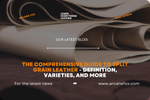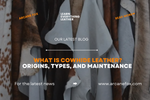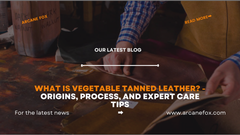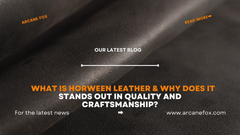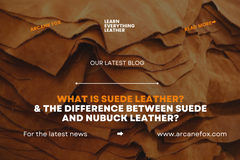What is The Difference Between Bonded Leather And Other Types of Leather
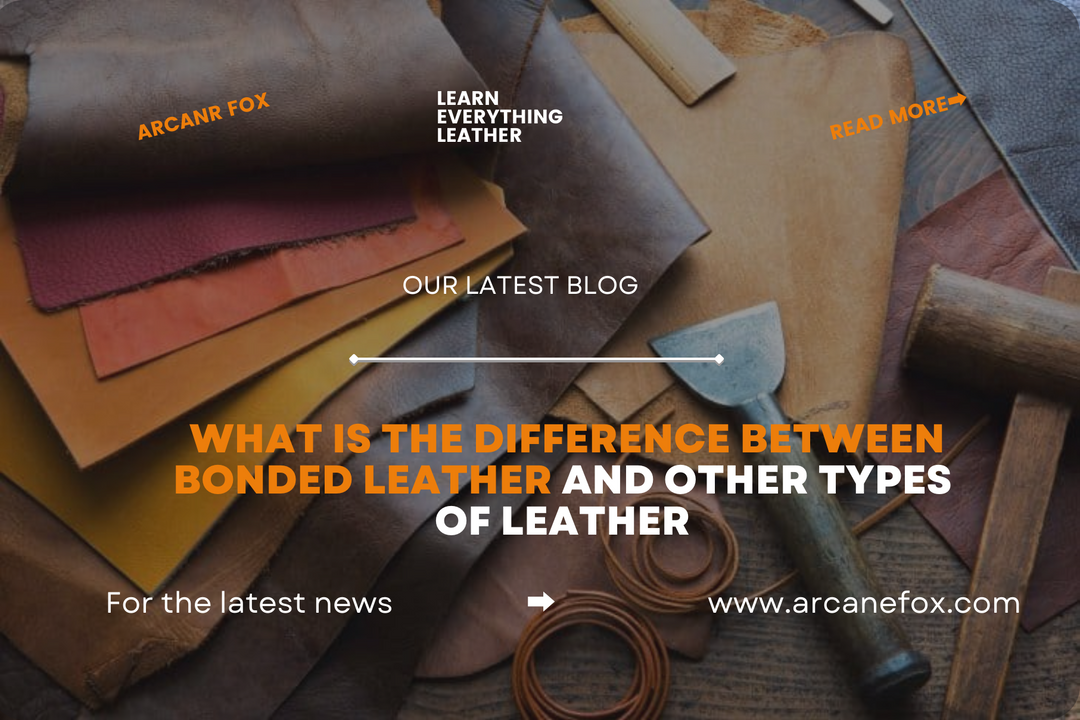
What is The Difference Between Bonded Leather And Other Types of Leather
Leather comes in a wide variety of varieties. One way to get the appearance of leather at a lesser price is with bonded leather.
A nearly synthetic leather is bonded leather. Its main component is pulverized leather fibers, which are then combined with a polyurethane (plastic) mixture and affixed to a backing made of paper or fiber. The most popular applications for this kind of leather include book binding, purses, and personal accessories.
This substance offers several advantages, which is why it is so well-liked and widely use. Let's examine the reasons why.
1. What is Bonded Leather?

A sort of leather made from ground-up leather scraps is called bonded leather. It permits the use of leather in completed goods in smaller pieces and of lower grades. This may be advantageous since it lessens the production of waste leather. It can also be a means of recycling older, worn-out leathers into newer materials. Reconstituted leather is another name for this kind of leather. Blended leather is another phrase that's utilize.
Bonded leather, which is create from leather scraps that have been finely shred and adhere using polyurethane or latex to a fiber/paper mesh or sheet, is somewhat comparable to scrapple or hot dogs of leather. The functional and aesthetic qualities of the finished product are affect by the actual leather content, which can range from 10% to 90%.
The surface is often stamp with a grain pattern to give it the appearance of a natural leather. An array of different, sometimes vivid, colors are apply to the surface providing many options for the color of the finished product. This makes it a material that is available in many styles, colors, and textures.
This leather typically has a shorter lifespan than natural leather. The product is made of plastic, which makes it less flexible than it could be. As a result, after a few years of use, it can start to wear and crack.
Cost, however, is a benefit. Bonded leather can be create for a lot less money than entirely natural leathers since it uses leftover leather and polymers. As a result, it has discovered a market for a variety of consumer goods. While it lasts, this leather can be quite appealing and cost-effective because it typically has the appearance and scent of real leather.
2. What is Bonded Leather Used for?

The production of upholstery for furniture is where bonded leather is most frequently employed. Among them are couches, sectionals, seats, stools, headboards, ottomans, lounge chairs, and other furniture. Many furniture companies provide bonded leather goods at relatively low prices as a means to possess "real leather" because they are significantly less expensive than natural leather.
The performance of this type of leather does not compare to that of natural leather, thus even while this might technically be partially true based on the variable amounts of leather present, it can be misleading. Without always being upfront about the true nature of the finished product, it is frequently a simple approach to draw attention to leather goods.
Additionally, book covers made of bonded leather are use. The material offers nearly unlimited alternatives for bookbinding because it protects well and can be fashion with any roughness. The applications are numerous and reasonably priced because it can be found in almost any color.
This kind of leather material is useful for clothing as well. It may be use in some boot and shoe components. So too may the interiors and even the exterior surfaces of clothing such as linings and headwear.
This leather is frequently use for briefcases, bags, some handbags, backpacks, protective cases, makeup bags, electronic device covers, and portfolios that are use for travel. It might be kept at home in protective bags or cases for media storage (CD and DVD), diploma covers, or folders.
Bonded leather is commonly used for belts, straps, wallets, keychains, eyeglass cases, sunglasses cases, jewelry boxes, key cases, credit card cases, and other modest, practical applications in personal accessories. Most products that would otherwise need natural leather can be made using it.
3. How To Tell If Its Bonded Leather
The cost of an item gives you a clear indicator of whether you are purchasing genuine leather. Bonded leather may appear to be real leather at first glance, but it lacks the thickness and softness of genuine leather and may even smell chemical.
4. Why Buy Bonded Leather?
Most people's decisions will be influence by the product's relatively low price, but some may opt for bonded leather since it can be seen as environmentally good because it uses leftovers, doesn't require extra farming, and, possibly, decreases landfill. The item is very simple to maintain and is probably available in a variety of design variations.
5. How is Bonded Leather Made?
5.1 Shredding
The fibers and fragments of leather are crushed up. These may be leftover trimmings from the manufacture of natural leather products. They may also originate from lower-grade hides, which can nevertheless be use in bonded leather applications even though they do not meet assessment standards for finished items.
5.2 Mixing
The fibers of the shred leather are then combine with a polyurethane or latex plastic combination. The fibers are held together by the plastic mixture as it dries and solidifies, which bonds them all together. This is frequently refer to as "bonded leather pulp," getting its name from the related procedure use to make paper.
Depending on the final purpose for the material, the precise components in the mixture can change significantly. Some could be harder, firmer, stronger, softer, or denser. Some of these concoctions are kept under wraps. They all support the final leather product's overall performance and feel.
5.3 Extrusion
Then, the uncured bonded mixture is extrude onto a flat backing. The material may be evenly push out onto the backing using machinery or by gravity and pouring.
The bonded material needs a safe surface to dry and stick to in order to take the final shape, hence a backing is require. Typically, the backing is construct of paper or a fiber (such as cotton, polyester, etc.). Fine mesh made of fiber, plastic, or metal can also be use to create it. This mesh offered more locations for the pulp to grab onto so that it would stick to the backing more firmly. The backing is then place aside to dry once the pulp has been extrude onto it in an equal layer.
The intended purpose of the finished product is frequently taken into account while choosing the backing. Bookbinders, for instance, may use bonded leather with a paper backing. Bonded leather on a cloth backing might be use by upholstery professionals.
5.4 Dyeing/Coloring
The leather can be dye after the pulp has dried on the backing. Typically, this is a surface treatment that doesn't go very far into the material. The color of bonded leather only permeates the surface (and does not go through the synthetic plastic), in contrast to natural leather, which typically has dye that penetrates completely. Almost any color can be apply by painting or dyeing to the surface.
5.5 Stamping/Embossing
The bonded leather can have its surface textured after being colour. This can be use to simulate a natural leather's grain in appearance. It can also be use to imprint a selected, eye-catching design.
Stamping bonded leather is solely aesthetic for finishing purposes, unlike stamping natural leather, which is occasionally use to hide surface flaws. Because of the bonding and extrusion procedures, the bonded leather surface is often even.
Depending on the kind of products it will be use for, different textures may be prefer in the finished product. Bonded leather is an opportunity to incorporate fashionable and useful textures without difficulty because it is primarily made of synthetic materials.
5.6 Finishing
Bonded leather can be complete after being stamp or emboss. Typically, a synthetic surface protectant is use for this. It could give the leather a lustrous sheen. The surface finish may also offer a layer of defence for the material below. These coatings typically consist of a transparent polymer that is water- and scratch- and abrasion-resistant. Additionally, finishes may contain fragrances that help the bonded leather smell more like natural leather.
6. Bonded Leather Pros & Cons
6.1 Pros
- Cheaper than the majority of other types of leather
- Available in a variety of colors
- Available a variety of surface textures
- can be utilize in a variety of leather products.
- The material can be produce in very big sheets for heavy applications (like furniture).
- resembles and smells like genuine leather.
6.2 Cons
- not very adaptable
- Cracks in a short period of time
- Tears and scrapes are more challenging to repair on synthetic leather.
- is less durable than more natural leathers.
- differs from the feel of more natural leathers.
- Age typically makes things worse (as opposed to some natural leathers, which get better with use and care).
7. Leather Content of Bonded Leather
Given that bonded leather is a mixture of leather and plastic, it can be produce using a variety of formulas and proportions, depending on the desired outcome. This might be advantageous because leather can be repurpose for different uses in the future. Customers may also find it confusing because it's not always obvious exactly how much leather is utilize to create each piece of bonded leather.
Standards are constantly changing. It is advantageous to have a shared understanding of what the phrase "bonded leather" should signify, at least across different commercial regions.
7.1 How Durable Is Bonded Leather? And How Long Does Bonded Leather Last?
Natural leather is often more durable than bonded leather. The fibers are typically inaccessible for conditioning and treatment since they are blend with plastic. The plastic degrades, the surface starts to erode, and the substance starts to crack with time.
Usually, this takes place over a short period of time. When properly cared for, natural leather can endure a very long time. Bonded leather, on the other hand, can easily endure moisture, spills, general abrasions, and use because it is made of plastic. However, if it begins to malfunction, it does so rather quickly and is difficult to fix, typically taking two to three years.
7.2 What Causes Bonded Leather To Peel And Crack?

Bonded leather is less flexible than natural leather because it is made of plastic. Additionally, this kind of leather cannot be handled and maintained like natural leather because the natural fibers are hidden.
Bonded leather starts to separate from its backing when it is frequently bent, such as when sitting and moving around furniture. It starts to peel and flake off with time. The upholstery literally falls off as a result, producing an unattractive piece. The material's underlying layers become visible, and the surface's color is no longer consistent.
7.3 Is Bonded Leather Good Quality Leather?

Bonded leather is typically of poorer quality. This is mostly because the material is synthetic leather with natural leather fibers and grains mixed in, rather than being made of natural leather.
Bonded leather starts to flake, crack, and degrade after just a few years (about 2-4 years). This is a pretty short period to have a leather good when thinking about furniture or personal accessories.
7.4 Why Is Bonded Leather Bad?
Bonded leather has a much shorter lifespan than leather. It is prone to peeling and cracking, and once the damage has progressed too far, it is unsalvageable. Although bonded leather may be less expensive than genuine leather, due to its limited lifespan, the cost of replacing bonded leather items may end up being more over time. There is also the claim that it is now less environmentally friendly as a result.
8. Bonded Leather Vs Other Leather Types

8.1 Bonded Leather vs Genuine Leather
Genuine leather can be derived from any layer of the hide and is given surface treatments to give it a more consistent, "corrected," appearance. It can then be dye (or spray painted), stamped, or emboss to give it a final surface appearance after being sand or polish to remove surface defects.
Although not of the highest quality, the technique changes some of the leather's desirable characteristics, therefore it is frequently use for belts and other related products. Genuine leather outperforms and lasts longer than bonded leather because it is still a solid layer of natural hide.
8.2 Bonded Leather vs Full Grain Leather
This piece of leather hasn't been buff or sanded to get rid of any flaws; it still has the "grain" of the outer layer of the hide. On full grain leathers, usually only the hair is remove. The grain often contains fiber, more tightly packed fibers, which produces a surface that is exceptionally robust, resilient, and able to sustain demanding use.
It doesn't go through any sanding, therefore the surface may have a few little flaws. These could be the result of a cow brushing up against a fence, a minor cut, or simple scrapes from daily living. The most desirable hides are those with full grain and few imperfections because they are the least frequent and have the best appearance.
The biggest strength of any leather kind comes from those surface fibers. As a result, it works well for furniture, shoes, and saddlery. Since the outer coating is left in place, it gradually acquires a patina (a surface color change through use) that can be aesthetically appealing. Additionally, the outer layer offers some water resistance properties. The best leather on the market is thought to be full grain.
Full grain leather will perform better and last longer than bonded leather.
8.3 Bonded Leather vs Top Grain Leather
The top layer of this cut has been sand and/or polished to remove flaws and irregularities in the finish, which makes it extremely comparable to full-grain. When various colors and finishes are put on the leather, it becomes softer and more malleable.
While this sanding improves the appearance, it also takes away from the full grain leather's resilience and some of its water-repellent properties. As a result, we start to notice a trade-off between leather's strength, appearance, and softness.
Top grain leather is frequently use in high end leather items, such as handbags, wallets, and shoes, due to its softness and flexibility.
Within a few years, bonded leather will start to crack and flake, and it won't function as effectively as top grain leather.
8.4 Bonded Leather vs Faux Leather
A sort of synthetic leather known as faux leather is often construct of vinyl or polyurethane. Although intended to resemble real leather, faux leather is much less expensive. It is frequently use in the furniture sector and offers the advantages of being affordable (in comparison to real leather), robust, and simple to clean.
However, it does not accurately represent real leather's characteristics, which include superior wear over time, natural stretchability, breathability, resistance to cuts and other abrasions, and a distinctive natural look and feel.
Faux leather won't flake and fracture over time like bonded leather because it often has a stable composition of its substance. Early on, bonded leather will have a little more leather-like appearance and fragrance.
8.5 Bonded Leather vs Imitation Leather
Faux leather is also refer to as imitation leather. As previously said, unlike bonded leather, imitation leather typically does not flake and fracture over time. Bonded leather will initially look and smell more like genuine leather, but it will wear out far more quickly.
8.6 Bonded Leather vs Vinyl
Faux leather is also refer to as vinyl leather. As previously said, unlike bonded leather, imitation leather typically does not flake and fracture over time. Bonded leather will initially look and smell more like genuine leather, but it will wear out far more quickly.
8.7 Bonded Leather vs PU Leather
Faux leather is also refer to as "PU leather." As previously said, unlike bonded leather, imitation leather typically does not flake and fracture over time. Bonded leather will initially look and smell more like genuine leather, but it will wear out far more quickly.
8.8 Bonded Leather vs Leather Bound
These two kinds of leather are possible options for book binders. Natural leather will typically be stronger, last longer, and feel better when worn. Bonded leather will be more affordable, offer less protection for the book, and last longer.
8.9 Bonded Leather vs Leather Gel
Leather Gel, a product sold by King Textiles, is a synthetic leather with a "breathable" backing. This makes it practical for uses like upholstery and textiles, where air movement can improve user comfort.
It will typically function better than bonded leather because it is a synthetic leather with a high abrasion tolerance. Bonded leather will age more quickly and fracture and peel.
8.10 Bonded Leather vs Polyurethane
Faux leather is also refer to as polyurethane (PU) leather. As previously said, unlike bonded leather, imitation leather typically does not flake and fracture over time. Bonded leather will initially look and smell more like genuine leather, but it will wear out far more quickly.
9. Bonded Leather Care & Maintenance

If handled with care, given regular attention, cleaned thoroughly, and kept properly, bonded leather can maintain its visual appeal and pleasant scent for a number of years.
9.1 How to Clean Bonded Leather
Bonded leather may be clean delicately with a moist towel due to its polished surface. Make sure the material is free of lint and loose fibers that might transfer to the surface. A microfiber cloth might be useful. Additionally, try the cloth in a tiny area first to ensure that it won't cause any color to transfer to the surface of the object (couch, sofa, bag, pocketbook, etc.).
A very soft brush can assist remove dirt and grime if the object requires more cleaning. While being careful not to push too hard, lightly moisten it and massage it over the leather. The majority of the job needs to be performe by the brush's bristles. Following this procedure, wiping it down with a moist cloth can help remove any dust or dirt that may have remained. Before using or storing the item, allow it to dry.
Additional care may be require if the substance you are attempting to clean is a stain from anything rather than just dust or filth. First, analyze the stain's type. Knowing the chemical might help you choose the appropriate cleaning technique. If it's something simple, a mild cleaning might be effective.
Investigate cleansers created especially for bonded leather if the issue is more serious. They will be designe to remove the stain and preserve the surface finish. As with most cleaners, always test a tiny, inconspicuous area first to make sure the bag won't become discolored. Avoid making a second stain while attempting to remove the first.
9.2 How to Condition Bonded Leather
Bonded leather does not require conditioning because it has a protective surface finish. And practically speaking, it cannot. The leather beneath is shield by the polish on the surface. Additionally, it acts as a barrier that the conditioner cannot cross.
But thankfully, the protective surface makes cleaning with a moist towel a breeze. This is a simple approach to guarantee that bonded leather products look fantastic at all times. Additional protectant can be use if the surface layer starts to erode in order to assist recover it.
Some of these products will be spray on and then remove, while others will be apply with a cloth or other applicator. Before applying any finish to the entire item, read the directions carefully and try it on a tiny area to ensure that it won't stain the surface.
9.3 How to Fix a Scratch on Bonded Leather
Applying a leather repeat kit frequently solves the problem of repairing a scratch on a piece of bonded leather. Since bonded leather is a combination of leather and plastic, the scratched-off material will need to be replace.
Typically, color-matched liquid is put into the fracture in leather repair kits. It may need to be evened, heated, given a grain pattern, and/or given time to dry before the scratch is filled.
9.4 How to Fix Tears in Bonded Leather
Bonded leather tears are more difficult to repair than scratches. Given that bonded leather is a leather/plastic hybrid, repairing tears may need a repair kit with filler. The tear's empty spot will need to be filled.
This can be accomplish using fabric, flexible glue, or the color-matched liquid that is provided in the repair kit, depending on the size of the tear. The substance use as a filler must be flexible once dry as well because the item will probably be use, sat on, or otherwise need to flex.
Just patch the residual scratch that is visible above the tear once it has been filled. Pour the liquid that matches the color into the crack. It may need to be evened, heated, given a grain pattern, and/or given time to dry before the scratch is filled.
9.5 How to Store Bonded Leather
Bonded leather needs to be kept in a cool, dry location. The protective finish might become discolored by sunshine, therefore keeping it out of direct sunlight is essential. The majority of furnishings are kept indoors, making it an ideal location for them.
Storage in a closet or drawer is ideal for leather garments and accessories. The key is to keep them out of direct sunshine and very high moisture levels.
Bonded leather has several advantages in terms of cost and similarity to the appearance and smell of genuine leather. This kind of leather can be look into as a possible purchase or material for a new project.
10. Conclusion
In comparing bonded leather to other types of leather, we delve into a realm where style, longevity, and ethical considerations converge. Bonded leather stands out for its innovative use of leather scraps combined with synthetic materials, offering an eco-friendly and cost-effective alternative. This approach not only makes efficient use of resources but also provides a more affordable option for consumers.
However, when it comes to durability and aesthetic richness, bonded leather often falls short of traditional leathers like full-grain or top-grain. These classic varieties boast longer lifespans and a distinct natural beauty, featuring unique textures and patterns that bonded leather cannot replicate. Full-grain leather, in particular, is revered for its authenticity and luxurious feel, symbolizing both quality and timelessness.
Ultimately, the choice between bonded leather and other types of leather reflects our personal values and needs. Whether we prioritize sustainability and affordability with bonded leather or the traditional elegance and resilience of full-grain leather, our selection is a testament to our individual preferences and lifestyles. This decision is more than just about material; it's about aligning with our unique stories and values.
Learn more about leather here: Leather 101 - The Ultimate Guide to Different Types of Leather
Related Posts
What is full-grain leather? Everything You Need to Know
What is Top Grain Leather? The Comprehensive Guide
Is Genuine Leather a Real Leather? Quality, Durability, and More
The Comprehensive Guide to Split Grain Leather - Definition, Varieties, and More

